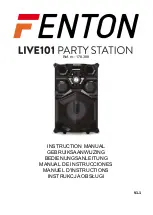
___________________________________________________________________7. CLEANING
____________________________________________________________________________
23
CITIZEN 6 - 9/MC, CITIZEN 6+6 - 9+9/MC ELECTROMECHANICAL VERSION
7. CLEANING
At the end of each working day (or more frequently if possible) it is
necessary to carefully clean the cooking surface and all the parts of the oven
which come into contact with the food being cooked to avoid that any food
substances go off and contaminate either the working environment or later
products to be cooked.
Before cleaning is carried out, the oven should be turned off and at
room temperature with the oven disconnected from the mains electricity
supply by means of the mains switch on the switchgear.
7.1 Cleaning the exposed parts
The tempered glass parts are particularly sensitive to sudden variations
in temperature that can cause them to crack into tiny fragments.
Do not
handle glass parts and do not bring them into contact with water until
they have cooled down to room temperature.
It is not recommended to use abrasive tools (abrasive sponges or
similar) because over time they take the shine off the stainless steel parts
and high impact glass. The best idea is to wash the various removable parts
before food residues have had time to dry up.
7.2 Cleaning the parts made from ceramic refractory material
To remove cooking residue from surfaces made from ceramic refractory
material, use a brush. If residue is stuck to these surfaces, prise them off
gently with a spatula.
Do not use any form of liquid especially detergent because the
refractory material is porous and it cannot be rinsed to remove residue that
comes into contract with these surfaces.
Do not use clearing tools which are too pointed or abrasive because the
refractory material is fragile and could easily chip or even break.
















































